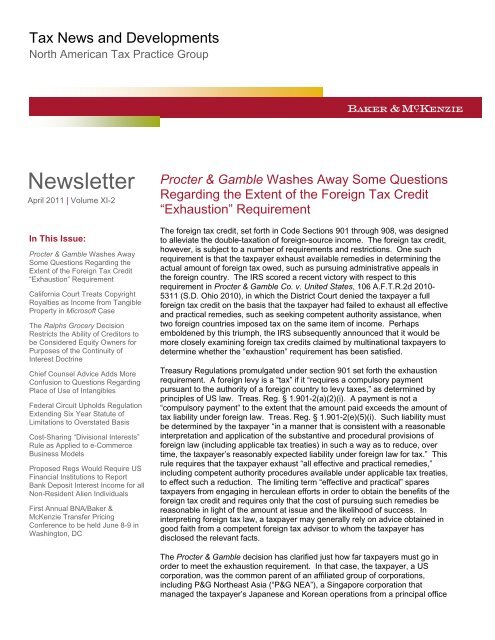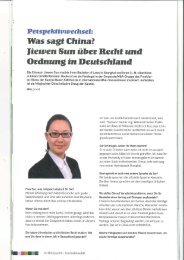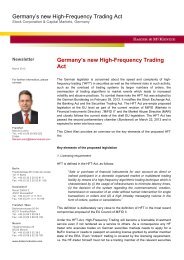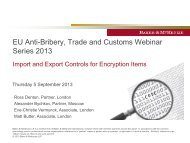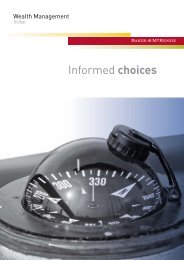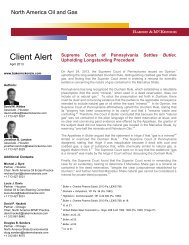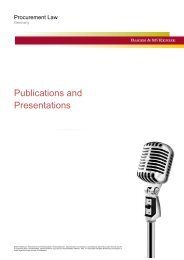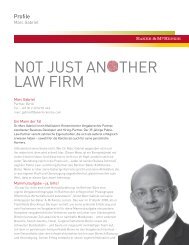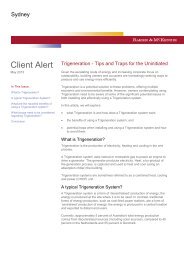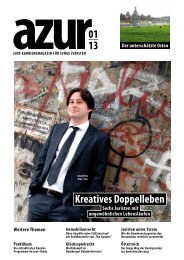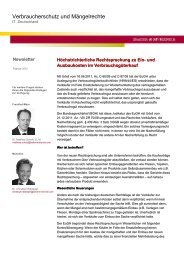Procter & Gamble - Baker & McKenzie
Procter & Gamble - Baker & McKenzie
Procter & Gamble - Baker & McKenzie
You also want an ePaper? Increase the reach of your titles
YUMPU automatically turns print PDFs into web optimized ePapers that Google loves.
Tax News and Developments<br />
North American Tax Practice Group<br />
Newsletter<br />
April 2011 | Volume XI-2<br />
In This Issue:<br />
<strong>Procter</strong> & <strong>Gamble</strong> Washes Away<br />
Some Questions Regarding the<br />
Extent of the Foreign Tax Credit<br />
“Exhaustion” Requirement<br />
California Court Treats Copyright<br />
Royalties as Income from Tangible<br />
Property in Microsoft Case<br />
The Ralphs Grocery Decision<br />
Restricts the Ability of Creditors to<br />
be Considered Equity Owners for<br />
Purposes of the Continuity of<br />
Interest Doctrine<br />
Chief Counsel Advice Adds More<br />
Confusion to Questions Regarding<br />
Place of Use of Intangibles<br />
Federal Circuit Upholds Regulation<br />
Extending Six Year Statute of<br />
Limitations to Overstated Basis<br />
Cost-Sharing “Divisional Interests”<br />
Rule as Applied to e-Commerce<br />
Business Models<br />
Proposed Regs Would Require US<br />
Financial Institutions to Report<br />
Bank Deposit Interest Income for all<br />
Non-Resident Alien Individuals<br />
First Annual BNA/<strong>Baker</strong> &<br />
<strong>McKenzie</strong> Transfer Pricing<br />
Conference to be held June 8-9 in<br />
Washington, DC<br />
<strong>Procter</strong> & <strong>Gamble</strong> Washes Away Some Questions<br />
Regarding the Extent of the Foreign Tax Credit<br />
“Exhaustion” Requirement<br />
The foreign tax credit, set forth in Code Sections 901 through 908, was designed<br />
to alleviate the double-taxation of foreign-source income. The foreign tax credit,<br />
however, is subject to a number of requirements and restrictions. One such<br />
requirement is that the taxpayer exhaust available remedies in determining the<br />
actual amount of foreign tax owed, such as pursuing administrative appeals in<br />
the foreign country. The IRS scored a recent victory with respect to this<br />
requirement in <strong>Procter</strong> & <strong>Gamble</strong> Co. v. United States, 106 A.F.T.R.2d 2010-<br />
5311 (S.D. Ohio 2010), in which the District Court denied the taxpayer a full<br />
foreign tax credit on the basis that the taxpayer had failed to exhaust all effective<br />
and practical remedies, such as seeking competent authority assistance, when<br />
two foreign countries imposed tax on the same item of income. Perhaps<br />
emboldened by this triumph, the IRS subsequently announced that it would be<br />
more closely examining foreign tax credits claimed by multinational taxpayers to<br />
determine whether the “exhaustion” requirement has been satisfied.<br />
Treasury Regulations promulgated under section 901 set forth the exhaustion<br />
requirement. A foreign levy is a “tax” if it “requires a compulsory payment<br />
pursuant to the authority of a foreign country to levy taxes,” as determined by<br />
principles of US law. Treas. Reg. § 1.901-2(a)(2)(i). A payment is not a<br />
“compulsory payment” to the extent that the amount paid exceeds the amount of<br />
tax liability under foreign law. Treas. Reg. § 1.901-2(e)(5)(i). Such liability must<br />
be determined by the taxpayer “in a manner that is consistent with a reasonable<br />
interpretation and application of the substantive and procedural provisions of<br />
foreign law (including applicable tax treaties) in such a way as to reduce, over<br />
time, the taxpayer’s reasonably expected liability under foreign law for tax.” This<br />
rule requires that the taxpayer exhaust “all effective and practical remedies,”<br />
including competent authority procedures available under applicable tax treaties,<br />
to effect such a reduction. The limiting term “effective and practical” spares<br />
taxpayers from engaging in herculean efforts in order to obtain the benefits of the<br />
foreign tax credit and requires only that the cost of pursuing such remedies be<br />
reasonable in light of the amount at issue and the likelihood of success. In<br />
interpreting foreign tax law, a taxpayer may generally rely on advice obtained in<br />
good faith from a competent foreign tax advisor to whom the taxpayer has<br />
disclosed the relevant facts.<br />
The <strong>Procter</strong> & <strong>Gamble</strong> decision has clarified just how far taxpayers must go in<br />
order to meet the exhaustion requirement. In that case, the taxpayer, a US<br />
corporation, was the common parent of an affiliated group of corporations,<br />
including P&G Northeast Asia (“P&G NEA”), a Singapore corporation that<br />
managed the taxpayer’s Japanese and Korean operations from a principal office
Upcoming Tax Events:<br />
A Basic Introduction to China<br />
Tax, M&A and Structure<br />
Considerations<br />
Webinar<br />
April 26, 2011<br />
State and Local Tax Roundtables<br />
State Limitations on Transfer<br />
Pricing: Other Current<br />
Developments<br />
Dallas<br />
April 26, 2011<br />
Houston<br />
April 27, 2011<br />
Focus on Japan: Coping with the<br />
Business and Legal Aftershocks<br />
Webinar Series<br />
April - May 2011<br />
2011 European Tax Seminar<br />
London, England<br />
May 18, 2011<br />
BNA/<strong>Baker</strong> & <strong>McKenzie</strong> Transfer<br />
Pricing Conference<br />
Washington, DC<br />
June 8-9, 2011<br />
Tax Planning & Transactions<br />
Workshop<br />
New York, NY<br />
June 24, 2011<br />
Global Transfer Pricing<br />
Workshop<br />
Bellevue (Seattle), WA<br />
July 22, 2011<br />
2 Tax News and Developments �April 2011<br />
<strong>Baker</strong> & <strong>McKenzie</strong><br />
located in Japan. During the years at issue, P&G NEA paid royalties to the<br />
taxpayer and withheld a 10 percent Japanese tax, but paid no taxes to Korea.<br />
The taxpayer claimed a foreign tax credit with respect to the Japanese taxes. In<br />
2006, the Korean tax authorities audited the taxpayer and determined that a<br />
portion of the royalties paid by P&G NEA was attributable to Korean sales and<br />
thus subject to a Korean withholding tax of 15 percent (as well as a 1.5 percent<br />
local surcharge), even though P&G NEA had no physical location or employees<br />
in Korea.<br />
The taxpayer engaged a prominent Korean law firm and received a legal opinion,<br />
which concluded that the Korean tax was properly assessed under both Korean<br />
tax law and the US-Korea Income Tax Treaty. The opinion further advised that<br />
any challenge would be unlikely to succeed. Based on this advice, the taxpayer<br />
determined that there was no reasonable basis for disputing the Korean<br />
assessment or invoking the competent authority procedures under the US-Korea<br />
Income Tax Treaty and instead paid the tax. The taxpayer then filed a refund<br />
claim with the IRS requesting an additional foreign tax credit for the Korean taxes<br />
paid. The IRS disallowed the credit on the grounds that the taxpayer had failed<br />
to exhaust all effective and practical remedies. In response, the taxpayer filed<br />
suit in District Court.<br />
The court began by explaining that the exhaustion requirement is a “core<br />
component” of the foreign tax credit system. Its absence would create a “moral<br />
hazard,” the court continued, as “[t]axpayers would have no incentive to<br />
challenge any foreign tax whether or not properly imposed, thereby leaving the<br />
United States to foot the bill through the credit system.” In the case at bar, the<br />
court held that the taxpayer should have sought a redetermination of its<br />
Japanese tax or invoked competent authority proceedings regarding its<br />
Japanese tax liability. Thus, while Korea and Japan may ultimately uphold their<br />
claims on the same item of income, the court noted that the “onus” was on the<br />
taxpayer to exhaust all effective and practical remedies in both countries before<br />
claiming a foreign tax credit. The court required that the taxpayer “at least<br />
investigate the possibility of challenging these claims.” Although the taxpayer<br />
had consulted with Korean counsel, the court pointed out that the taxpayer had<br />
not obtained any advice from Japanese counsel, implying that, had the taxpayer<br />
obtained a similarly adverse opinion with respect to the possibility of challenging<br />
its Japanese tax liability, the exhaustion requirement would have been fulfilled.<br />
Thus, the court held, on a summary judgment motion, that the taxpayer was<br />
entitled to a foreign tax credit only in the amount of the withholding tax payments<br />
it made to Korea, and the taxpayer could not also claim additional credit in the<br />
amount of the withholding tax payments it made to Japan. Given the fact that the<br />
taxpayer had already received a tax credit for its Japanese taxes, the court<br />
mandated that the taxpayer’s credit for Korean taxes be reduced by the amount<br />
already allowed as a credit for Japanese taxes.<br />
In addition to its success in <strong>Procter</strong> & <strong>Gamble</strong>, the IRS has recently warned<br />
taxpayers and practitioners more broadly that it would be closely scrutinizing<br />
foreign tax credit claims to ensure that the exhaustion requirement is met. On<br />
February 16, 2011, Michael Danilack, Deputy Commissioner (International) of the<br />
IRS Large Business and International Division, spoke at a Tax Policy Institute<br />
Conference regarding foreign tax credits. Danilack emphasized the IRS’ concern<br />
that claimed foreign tax credits be “legitimate” and indicated that the IRS would<br />
be asking multinational taxpayers “more serious questions” about its credits than<br />
it had in the past. Danilack specifically mentioned that the IRS would be<br />
examining whether “administrative remedies have been exhausted before those<br />
credits are taken.” See Tamu N. Wright, Cross-Border Taxation: Danilack Invites
3 Tax News and Developments �April 2011<br />
<strong>Baker</strong> & <strong>McKenzie</strong><br />
Competent Authority Calls, Warns IRS Scrutinizing Foreign Tax Credits, Daily<br />
Tax Report, 33 DTR G-4 (Feb. 17, 2011).<br />
Unfortunately, with foreign tax authorities throughout the world facing depleted<br />
coffers, the situation faced by the taxpayer in <strong>Procter</strong> & <strong>Gamble</strong> is not unique,<br />
and multinationals often find themselves subject to competing tax claims on the<br />
same items of income. <strong>Procter</strong> & <strong>Gamble</strong> illustrates the critical role that<br />
competent authority can play in resolving such multi-jurisdictional disputes.<br />
Moreover, the exhaustion requirement mandates that taxpayers at least<br />
investigate the involvement of competent authority as well as other potential<br />
remedies in each affected jurisdiction prior to claiming a foreign tax credit.<br />
Perhaps one comfort that taxpayers can draw from <strong>Procter</strong> & <strong>Gamble</strong> is that a<br />
legal opinion from a foreign advisor concluding that a challenge to the<br />
assessment is unlikely to be successful will ordinarily satisfy the exhaustion<br />
requirement for that jurisdiction, and a court will generally not require the<br />
taxpayer to pursue costly overseas litigation with little chance of success. With<br />
the convergence of increased audit and assessment activity by foreign tax<br />
authorities and the IRS’ invigorated focus on the foreign tax credit exhaustion<br />
requirement, the tax departments of multinational taxpayers have yet another tax<br />
issue to monitor on top of their already lengthy list.<br />
By Daniel V. Stern, Washington, DC<br />
California Court Treats Copyright Royalties as<br />
Income from Tangible Property in Microsoft Case<br />
The San Francisco Superior Court recently denied Microsoft Corporation’s<br />
(“Microsoft”), claim for refund of over $30 mil in franchise (income) taxes plus<br />
applicable interest and penalties imposed by the California Franchise Tax Board<br />
(“FTB”). Microsoft Corp. v. FTB, Case No. CGC 08-471260 (Feb. 17, 2011).<br />
The case involved four issues:<br />
1. Whether Microsoft’s receipts from licensing its proprietary computer<br />
software to original equipment manufacturers (OEMs) was income from<br />
tangible property or intangible property?<br />
2. Whether receipts from Microsoft’s Treasury operations should be<br />
excluded from the denominator of Microsoft’s sales factor?<br />
3. Whether the standard apportionment formula should be modified to<br />
include the value of Microsoft’s intangible property?<br />
4. Whether the FTB was statutorily and constitutionally authorized to<br />
assess the amnesty penalties against Microsoft?<br />
Two of these were issues of first impression in California: whether software<br />
licensing income gives rise to income from tangible or intangible property and<br />
whether intangible property should be included in the property factor for a<br />
company like Microsoft where the value of intangible property exceeds that of<br />
tangible property.<br />
During tax years ending 1995 and 1996 (“Periods at Issue”), Microsoft’s business<br />
activities included manufacturing, distributing, and licensing its proprietary<br />
computer software to OEMs. Microsoft’s licensed software products were carried<br />
on “Golden Master” disks, which licensees used to copy Microsoft’s software
4 Tax News and Developments �April 2011<br />
<strong>Baker</strong> & <strong>McKenzie</strong><br />
onto hard drives on computers they built and sold and back-up disks included<br />
with the assembled computer units. The Microsoft license gave OEMs the right<br />
to install Microsoft software into OEM computer systems and sell those<br />
computers with the pre-installed software.<br />
Income from Copyright Rights<br />
In this case, Microsoft argued that its royalty income constituted receipts from the<br />
licensing of something “other than tangible personal property,” i.e., intangible<br />
property (“IP”). As such, the income should be sourced under California’s “costsof-performance”<br />
method. Cal. Rev. & Tax Code Section 25136. Under this<br />
method, Microsoft’s IP royalties would be sourced entirely to Washington, where<br />
the majority of the IP’s income-producing activity took place, thus significantly<br />
reducing Microsoft’s California franchise tax liability. The court rejected<br />
Microsoft’s argument, holding that the royalties constituted receipts from the<br />
licensing of tangible as opposed to intangible personal property, and thus should<br />
be sourced to California if the licensed property is located in the state. Cal. Code<br />
Regs. 25136(d)(2)(B). Pointing to the “Golden Master” disk format, the court<br />
stated that “the computer software licensed by Microsoft was inextricably<br />
intertwined with the disks on which they were embedded” and therefore “the<br />
royalties from the licensing of such programs should be classified as deriving<br />
from the sale of tangible personal property.”<br />
In reaching this conclusion, the Trial Court relied primarily on sales tax cases<br />
treating the sale of canned software as tangible property along with other<br />
authorities classifying the transfer of software to an end user as a transaction<br />
involving tangible personal property. The Trial Court failed to cite any authorities<br />
dealing with the license of copyright rights, such as the right to reproduce<br />
involved in Microsoft’s case. The federal tax regulations in Treas. Reg. § 1.861-<br />
18, distinguishing between a copyrighted article and a copyright right, were<br />
summarily dismissed by the Trial Court as “unpersuasive.” The Court failed to<br />
grasp the fundamental distinction between tangible objects and intangible rights.<br />
Treasury Receipts<br />
Microsoft also protested the FTB’s exclusion of total gross receipts from the sale<br />
or disposition of marketable securities from its sales factor denominator. In<br />
making its adjustment, the FTB sought to modify the standard three-factor<br />
apportionment formula, pursuant to Cal. Rev. & Tax Code Section 25137.<br />
Microsoft’s marketable securities were handled by its Treasury Department in<br />
Washington, and any sales or dispositions occurred entirely out-of-state. Under<br />
the standard apportionment formula, such total gross receipts would have<br />
increased the size of Microsoft’s sales factor denominator without affecting its<br />
numerator, thus significantly reducing its California franchise tax liability. The<br />
court upheld the FTB’s use of a modified three-factor-formula, holding that only<br />
net receipts from the marketable securities should be included in Microsoft’s<br />
sales factor. In so doing, the court largely followed the reasoning of prior<br />
decisions in Microsoft Corp. v. Franchise Tax Board, 39 Cal. 4th 750 (Cal. 2006)<br />
and Limited Stores, Inc. v. Franchise Tax Board, 152 Cal. App. 4th 1491 (Cal.<br />
2007).
5 Tax News and Developments �April 2011<br />
Property Factor Modification<br />
<strong>Baker</strong> & <strong>McKenzie</strong><br />
The court also rejected Microsoft’s argument that the three-factor apportionment<br />
formula should be modified to include the value of Microsoft’s IP. Microsoft<br />
sought modification under section 25137, arguing that the failure to include IP in<br />
its property factor unfairly reflected the extent of Microsoft’s California business<br />
activity. Clearly, Microsoft’s IP represents a major business income producing<br />
asset that is core to its business. The court rejected this argument, holding that<br />
Microsoft failed to establish by clear and convincing evidence that modification<br />
was warranted.<br />
Penalties<br />
Finally, the court also upheld the imposition of amnesty penalties, imposed<br />
pursuant to Cal. Rev. & Tax Code Section 19777.5. Microsoft argued that the<br />
penalty statute was void because it operated retroactively, was unconstitutionally<br />
vague, and did not provide an opportunity for administrative or judicial prepayment<br />
or post-payment review. Instead, the court held that the statute did not<br />
operate retroactively, as it did not increase the amount of a taxpayer’s underlying<br />
tax liability, but rather increased “the consequences of not paying the proper<br />
amount for the years at issue within the dictates of the amnesty program.” The<br />
court also held that the amnesty penalty statute was not vague as applied to<br />
Microsoft, and there was adequate opportunity for pre-payment and postpayment<br />
review.<br />
Significance of Case<br />
In practice, the FTB has long treated end-user software, even when delivered<br />
electronically, as tangible personal property, and a few taxpayers have received<br />
informal written statements from the FTB confirming this position. However, we<br />
are not aware of previous instances where the FTB publicly staked out the<br />
position that the license of copyright rights produced income from tangible<br />
property for apportionment purposes. The impact of the court’s decision<br />
depends on the location of the taxpayer. Classification as income from tangible<br />
property is helpful to California-based software companies licensing to out-ofstate<br />
unrelated parties who reproduce and distribute the software. Conversely<br />
this classification results in higher California apportionment for out-of-state<br />
software licensors licensing to California based OEMs, like Microsoft. If<br />
California switches from elective to mandatory single sales factor, the effects of<br />
this decision will be doubly important (and disadvantageous) for out-of-state<br />
software licensors. At the time this article was written, Microsoft had not<br />
announced whether it will appeal the decision.<br />
By Scott L. Brandman, New York, J. Pat Powers, Palo Alto<br />
and Sahang-Hee Hahn, New York
6 Tax News and Developments �April 2011<br />
<strong>Baker</strong> & <strong>McKenzie</strong><br />
The Ralphs Grocery Decision Restricts the Ability<br />
of Creditors to be Considered Equity Owners for<br />
Purposes of the Continuity of Interest Doctrine<br />
Judge Chiechi of the Tax Court recently issued a surprising decision in Ralphs<br />
Grocery Co. v. Commissioner, T.C. Memo 2011-25, significantly limiting the<br />
ability of creditors of a bankrupt company to qualify as equity owners of the<br />
company for purposes of the continuity of interest (“COI”) doctrine. The Tax<br />
Court, strictly interpreting the facts in Helvering v. Alabama Asphaltic Limestone<br />
Co., 315 U.S. 179 (1942), held that creditors of a bankrupt company must have<br />
“effective command” over the property of the company for the creditors to qualify<br />
as equity owners in the company. The strict requirements of Ralphs Grocery<br />
could thus limit the number of pre-1998 (and possibly post-1997) bankruptcy<br />
reorganizations that can be structured as nontaxable reorganizations.<br />
In Ralphs Grocery, Federated Stores, Inc. (“FSI”) was the domestic parent of a<br />
consolidated group of corporations. FSI held all of the outstanding stock of<br />
Holdings III, Inc. (“Holdings III”). Holdings III, in turn, indirectly held all of the<br />
outstanding stock of Allied Stores Corp. (“Allied”) and directly held 83.75% of the<br />
outstanding stock of Ralphs Grocery Co. (“Ralphs”). Allied held the remaining<br />
16.25% of the outstanding stock of Ralphs.<br />
In 1990, FSI and Allied filed petitions under Chapter 11 of the Bankruptcy Code.<br />
At no time did Ralphs file a petition. In 1992, the bankruptcy court confirmed a<br />
Chapter 11 bankruptcy plan (the “Plan”) proposed by FSI and Allied. Pursuant to<br />
the Plan, a newly formed domestic company, Ralphs Holding Co., Inc. (“RHC”),<br />
acquired all of the outstanding common stock of Ralphs from Holdings III and<br />
Allied (83.75% and 16.25% of the Ralphs common stock, respectively). In<br />
exchange for the Ralphs stock, RHC issued to Holdings III and Allied 83.75%<br />
and 16.25%, respectively, of its outstanding common stock. Thereafter, Holdings<br />
III transferred all of its RHC stock to FSI’s creditors, and Allied transferred 9.65%<br />
of its RHC stock to its creditors (the “Ralphs Transaction”). RHC and FSI filed a<br />
joint election under Code Section 338(h)(10) with respect to RHC’s acquisition of<br />
the common stock of Ralphs from Holdings III and Allied, thereby stepping up the<br />
basis of Ralph’s assets.<br />
The IRS asserted that the Ralphs Transaction qualified as a nontaxable<br />
reorganization under Code Section 368(a)(1)(B), (C) or (G), and that<br />
consequently RHC had a carryover basis under Code Section 362 in the Ralphs<br />
common stock it received. For the Ralphs Transaction to qualify as a nontaxable<br />
reorganization, the non-statutory COI doctrine must also be satisfied in addition<br />
to the statutory requirements under section 368. The COI doctrine generally<br />
requires that a target corporation’s shareholders must have a continuing interest<br />
in the acquiring corporation. Under pre-1998 law, relevant for the Ralphs<br />
Transaction that occurred in 1992, transitory ownership in the acquiring<br />
corporation by the target’s shareholders was disregarded in determining whether<br />
the COI requirement was satisfied. See, e.g. Penrod v. Commissioner, 88 T.C.<br />
1415, 1427 (1987); Heintz v. Commissioner, 25 T.C. 132, 142-143 (1955). As<br />
part of the Plan, assuming the Ralphs Transaction satisfied the statutory<br />
requirements of section 368(a)(1)(C) or (G), the historic shareholder (FSI) of the<br />
target (Holdings III) disposed of its interest in the acquiring corporation (RHC) to<br />
the creditors of FSI. The disposition of the RHC stock thus caused the Ralphs<br />
Transaction to fail the COI requirement under pre-1998 law.
7 Tax News and Developments �April 2011<br />
<strong>Baker</strong> & <strong>McKenzie</strong><br />
The COI doctrine would be satisfied, however, if the creditors were considered<br />
equity owners under Alabama Asphaltic. The parties stipulated (the critical<br />
litigating mistake of the IRS) that it was material to the Supreme Court’s holding<br />
in Alabama Asphaltic that the COI requirement would be satisfied if the creditors<br />
“had effective command over the disposition of the property.” The Tax Court<br />
reasoned that the creditors in Alabama Asphaltic had “effective command”<br />
because they took the necessary steps to enforce their rights to “exclude<br />
stockholders [of the bankrupt corporation] entirely from the reorganization plan”<br />
by instituting involuntary bankruptcy proceedings. In Ralphs Grocery,<br />
conversely, FSI filed a voluntary (and not involuntary) petition for bankruptcy.<br />
Moreover, FSI operated as a debtor in possession at all times during the FSI<br />
bankruptcy proceedings. The creditors did not ask the bankruptcy court to<br />
appoint a trustee, nor did it object to FSI operating as a debtor in possession.<br />
Lastly, FSI filed with the bankruptcy court the proposed Plan, and the FSI<br />
creditors never objected to or rejected that proposed Plan.<br />
The Tax Court also considered the Alabama Asphaltic progeny, see e.g., Palm<br />
Springs Holding Corp. v. Commissioner, 315 U.S. 185, 188-189 (1942); Wells<br />
Fargo Bank & Union Trust Co. v. United States, 225 F.2d 298, 300-301 (9th Cir.<br />
1955), noting that the creditors in those cases took proactive steps to enforce or<br />
protect their rights in the bankrupt corporations’ properties, such as filing a<br />
foreclosure action under mortgages securing the bankrupt corporations’ debt,<br />
selling the bankrupt corporations’ assets under an indenture, filing a receivership<br />
action against the bankrupt corporation, or entering into possession and<br />
operating the property of the bankrupt corporation. The creditors of FSI in<br />
Ralphs Grocery did not take any of these proactive steps. The Tax Court thus<br />
concluded that the Ralphs Transaction did not squarely fit under the facts in<br />
Alabama Asphaltic and its progeny, and thus the creditors could not be<br />
considered equity owners.<br />
The effect of Ralphs Grocery on post-1997 bankruptcy reorganizations remains<br />
unclear. First, for reorganizations occurring after January 28, 1998, Treas. Reg.<br />
§ 1.368-1(e)(1) permits historic target shareholders to dispose of their interest in<br />
the acquiring corporation without violating the COI requirement. Subject to<br />
substance-over-form or other anti-abuse judicial doctrines, historical<br />
shareholders of the bankrupt corporation could thus transfer the stock of the<br />
reorganized bankrupt corporation to its creditor(s) and still meet the COI<br />
requirement. However, for a creditor that receives stock of a reorganized<br />
bankrupt corporation in exchange for its debt claims directly from the reorganized<br />
bankrupt corporation (and not the historic shareholders), Ralphs Grocery<br />
arguably applies. Second, the IRS promulgated regulations, effective for<br />
bankruptcy reorganizations occurring on or after December 12, 2008, addressing<br />
whether creditors count positively towards the COI requirement. Under Treas.<br />
Reg. § 1.368-1(e)(6), if any creditor receives a proprietary interest in the<br />
reorganized bankrupt corporation in exchange for its claim, every claim of that<br />
class of creditors, and every claim of all equal and junior classes of creditors is a<br />
property interest. What remains unclear is whether the “effective command”<br />
requirement under Ralphs Grocery is an additional requirement to the 2008<br />
regulations.<br />
To the extent Ralphs Grocery applies to any post-1997 bankruptcy<br />
reorganization, creditors will be required to take the necessary formalistic steps<br />
to assert their control over the bankrupt corporation’s assets, including placing<br />
the debtor in involuntary bankruptcy and requesting the bankruptcy court to<br />
appoint a trustee. These requirements could severely restrict the number of<br />
bankruptcy reorganizations that could qualify as nontaxable reorganizations.<br />
By Elizabeth A. Lieb, Palo Alto
8 Tax News and Developments �April 2011<br />
<strong>Baker</strong> & <strong>McKenzie</strong><br />
Chief Counsel Advice Adds More Confusion to<br />
Questions Regarding Place of Use of Intangibles<br />
On October 13, 2010, the IRS Office of Chief Counsel issued Chief Counsel<br />
Advice 201106007 (the “CCA”), addressing whether the sale of software<br />
products by a controlled foreign corporation (“CFC”) into the US market gave rise<br />
to an investment in US property for purposes of Code Section 956(c)(1)(D). In<br />
general, a CFC is treated as holding an investment in US property for purposes<br />
of section 956 if it has any right to use in the United States a copyright which is<br />
acquired or developed by the CFC for use in the United States. Thus, in the<br />
case of a CFC that has rights with respect to software, it is necessary to<br />
determine where the underlying copyright rights are “used” to determine whether<br />
the CFC has made a section 956 investment in US property. The subject matter<br />
of the CCA is of particular interest given the muddled state of existing US tax law<br />
regarding the place of use of intangible property, which has relevance under<br />
sections 956, 861 and 954 (among others). Unfortunately, however, the CCA is<br />
not particularly helpful in resolving or shedding light on the inconsistencies in the<br />
existing case law and IRS guidance on the place of use of intangibles.<br />
The taxpayer involved in the CCA was a US entity that distributed information<br />
technology products and services. The taxpayer developed software in the<br />
United States under a cost-sharing agreement (“CSA”) with its wholly-owned<br />
foreign subsidiary, a CFC. The CSA was somewhat unusual in that the foreign<br />
subsidiary obtained the rights to exploit copyrights in the United States. When a<br />
newly-developed software product was ready for sale to end-user customers, the<br />
taxpayer first transferred the final version of the software code to a “gold master”<br />
disk which was sent to the subsidiary. The subsidiary then reproduced and sold<br />
copies of the software to end-user customers in the United States.<br />
The CCA reached three conclusions, with virtually no discussion of the<br />
underlying reasoning: (1) the foreign subsidiary made an investment in US<br />
property for purposes of section 956 when it acquired or developed the rights to<br />
use the copyrights in the United States under the CSA; (2) the actual sales of<br />
software copies to US customers were not in themselves an investment in US<br />
property; and (3) the transfer of software copies to US customers did not affect<br />
the calculation of the amount includible under section 956 on account of the<br />
subsidiary’s initial investment in US property because the CFC did not acquire or<br />
develop any additional, or relinquish any, rights to use the software rights in the<br />
United States as a result of selling the software copies to US end-users.<br />
Although the CCA neither provides the reasoning nor refers to any case law or<br />
prior administrative guidance to support its conclusions, its first (and most<br />
interesting) conclusion could only follow from the determination that the CFC had<br />
acquired the right to use the copyright in the United States with the intent to use<br />
such right in the United States. Thus, the CCA implicitly provides that acquisition<br />
of a copyright right that permits the CFC to reproduce offshore and sell software<br />
copies to US customers is the use of a copyright in the United States.<br />
In reaching its conclusion in the CCA, the IRS appears to have followed the<br />
reasoning it took in the so-called “textbook ruling” or Rev. Rul. 72-232, 1972-1<br />
C.B. 276 for determining the place of use of intangible property for sourcing<br />
purposes. In that ruling, a US publisher paid royalties to a nonresident for the<br />
right to print books and sell them outside the United States. The IRS ruled that<br />
although the books were printed in the United States, the royalties were entirely<br />
foreign source because “there [was] no commercial publication of the textbooks
9 Tax News and Developments �April 2011<br />
<strong>Baker</strong> & <strong>McKenzie</strong><br />
within the United States in that the textbooks [were] not sold within the United<br />
States.” Although, from a legal perspective, the printing of the books in the<br />
United States could not have been undertaken without a license of the US<br />
copyright rights, the IRS focused only on where the books were sold in<br />
determining where the copyrights were used for purposes of sourcing the<br />
royalties. Thus, the ruling suggests that intangible property is “used” for US tax<br />
purposes where the customers for the product are located.<br />
Notably, however, the IRS’s approach in the CCA is at odds with its own prior<br />
guidance in the software sale context which looked to the location of the<br />
licensee’s actual commercial activities with respect to the licensed intangibles to<br />
determine where such intangibles are used. In FSA 200222011, the IRS<br />
National Office advised that a royalty should be treated as wholly from US<br />
sources because the licensee performed its commercial activities related to the<br />
software in the United States. In that advice, a US company licensed the<br />
exclusive worldwide (except Country X) rights to sell, use, copy, manufacture or<br />
sublicense computer software from its Country X parent. The licensee’s software<br />
ultimately was sold to users both within and without the United States. The<br />
National Office did not look to where the ultimate customers were located in<br />
determining where the copyrights were used, but focused instead on the location<br />
of the licensee’s business activities. Unfortunately, the field service advice did<br />
not reference or distinguish the textbook ruling or any other authority, nor did it<br />
explain why it reached a contrary result.<br />
The CCA is also inconsistent with relevant case law. In Sanchez v.<br />
Commissioner, 6 T.C. 1141 (1946), aff’d, 162 F.2d 58 (2d Cir. 1947), the Tax<br />
Court held that the patent royalties were sourced by reference to the location of<br />
the payor’s business activities, and not by reference to where the products were<br />
ultimately consumed or which country’s laws protected the sale and use of the<br />
patented processes. Similarly, in Sabatini v. Commisioner, 32 B.T.A. 705 (1935),<br />
aff’d on this point, 98 F.2d 753 (2d Cir. 1938), the Board of Tax Appeals<br />
determined that a US licensee’s copyright royalty payments to a foreign person<br />
were from US sources where the publication and printing occurred in the United<br />
States, even though some of the rights related to the non-US markets.<br />
In sum, the CCA neither provides any useful rationale to support its conclusion<br />
nor attempts to address the inconsistencies in the IRS’ approach to determine<br />
the place of use of copyrights where a CFC sells software to US end-users but<br />
performs all of its actual operations outside the United States. Taxpayers are<br />
thus left to sort through existing legal authorities and erratic IRS approaches in<br />
determining where intangible property is used for US tax purposes.<br />
For further discussion regarding Chief Counsel Advice 201106007, see Gary D.<br />
Sprague’s upcoming article Section 956 Aspects of the Right to Duplicate and<br />
Sell Software in the US – a Wisp of Guidance from the Service, to be published<br />
in the May 2011 edition of Tax Management International Journal.<br />
By Diana B. Lathi and Paula R. Levy, Palo Alto
10 Tax News and Developments �April 2011<br />
<strong>Baker</strong> & <strong>McKenzie</strong><br />
Federal Circuit Upholds Regulation Extending Six<br />
Year Statute of Limitations to Overstated Basis<br />
In Grapevine Imports, Ltd. v. United States, No. 2008-5090 (Fed. Cir. Mar. 11,<br />
2011), the Federal Circuit considered whether the normal three-year statute of<br />
limitations applied to time-bar 2004 administrative adjustments made to a 1999<br />
partnership return on the grounds that the taxpayers had overstated their basis in<br />
certain assets via a tax shelter. The Code extends the period of limitations to<br />
adjust a return when the return “omits” certain items that should have been<br />
included in gross income. The IRS argued that the overstatement of basis in<br />
certain capital assets via a tax shelter constituted an omission of income<br />
sufficient to trigger the extended, six-year limitations period. See Code Sections<br />
6501(e)(1)(A), 6229(c)(2) (2004). The taxpayers countered that the normal<br />
three-year statute of limitations governed the IRS’ Final Partnership<br />
Administrative Adjustment (“FPAA”) and that the adjustments were therefore<br />
time-barred under sections 6501(a) and 6229(a). See section 6501(a) (2004)<br />
(stating the general rule that the IRS may not assess tax more than three years<br />
after the taxpayer’s return); id. section 6229(a) (2004) (reflecting the three-year<br />
limitations rule for tax attributable to partnership items). The Grapevine Court of<br />
Federal Claims relied upon the Supreme Court’s opinion in Colony, Inc. v.<br />
Commissioner, 357 U.S. 28 (1958), which held that under the precursor statute,<br />
overstatement of basis was not an omission from gross income and did not<br />
therefore trigger the extended limitations period. Grapevine Imports, Ltd. v.<br />
United States, 77 Fed. Cl. 505 (2007).<br />
At issue in Grapevine before the Federal Circuit was whether the government<br />
could invoke recently issued Treasury regulations to extend the limitations<br />
period, when judicial precedent limited the IRS’ ability to extend the limitations<br />
period. In Salman Ranch Ltd. v. United States, 573 F.3d 1362 (Fed. Cir. 2009),<br />
another panel of the Federal Circuit determined that the Colony holding was not<br />
limited to the context of income from the sale of goods or services by a trade or<br />
business. Accordingly, Salman Ranch concluded that overstatement of basis did<br />
not constitute an omission from gross income to trigger the extended six-year<br />
limitations period. Shortly after Salman Ranch was issued, the US Department<br />
of Treasury issued new regulations that disputed the Federal Circuit’s reasoning,<br />
stating that Treasury and the IRS disagreed that the Supreme Court’s reading of<br />
the predecessor to section 6501(e) in Colony applied to sections 6501(e) and<br />
6229(c)(2). 75 Fed. Reg. 78,897 (Sept. 28, 2009).<br />
In T.D. 9511, the IRS finalized these temporary regulations, which define an<br />
omission from gross income for purposes of the six-year statute of limitations for<br />
tax assessment set forth under sections 6229(c)(2) and 6501(e)(1)(A). The final<br />
regulations provide that the six-year limitations period for tax assessment applies<br />
to an overstatement of basis in a sold asset that results in an omission from<br />
gross income exceeding twenty-five percent of the income stated in the<br />
taxpayer’s tax return. Under Treas. Reg. § 301.6501(e)-1(a)(iii), “gross income,”<br />
as it relates to any income other than from the sale of goods or services in a<br />
trade or business, has the same meaning as provided under Code Section 61(a).<br />
In the case of amounts received from the disposition of property, gross income<br />
equates to the excess of the amount realized from the disposition of property<br />
over the unrecovered cost of basis of the property. Consequently, under the final<br />
regulations, an overstatement of basis that results in an understatement of<br />
income constitutes an omission from gross income for the purposes of section<br />
6501(e)(1)(A)(i) to which the extended six-year limitations period applies.
11 Tax News and Developments �April 2011<br />
<strong>Baker</strong> & <strong>McKenzie</strong><br />
The final regulations were made retroactively effective for all tax years for which<br />
the six-year limitations period for assessing tax was open on or after September<br />
24, 2009. Treas. Reg. § 301.6501(e)-1 (2010). Consequently, the new six-year<br />
limitations period provided in the final regulations effectively reopens tax years<br />
ordinarily closed under the ordinary three-year statute of limitations.<br />
On December 17, 2004, the IRS issued an FPAA that reduced the partners’<br />
basis in Grapevine by $10 million for 1999, necessitating a recomputation of the<br />
partners’ tax liability. Grapevine challenged the adjustment as untimely, arguing<br />
that the appropriate statute of limitations for such adjustments was three years<br />
under section 6501(a) (2004). Conversely, the government argued that<br />
Grapevine’s overstatement of basis – which led to understatement of gain and<br />
consequent underpayment of tax – triggered an extended six-year statute of<br />
limitations under section 6501(e)(1)(A) such that the adjustment was not timebarred.<br />
To determine whether it was bound by the prior precedential decision in Salman<br />
Ranch, the Federal Circuit considered what amount of deference it owed the<br />
intervening controlling authority reflected in the Treasury Department’s newly<br />
issued regulations. The court dismissed Grapevine’s argument that it was an<br />
abuse of discretion to retroactively apply the 2010 final regulations to a 1999 tax<br />
assessment. Relying on Mayo Found. for Med. Educ. & Research v. United<br />
States, 131 S. Ct. 704 (2011), the court interpreted the regulations under the<br />
standards set forth under Chevron, which require a court to defer to an agency’s<br />
reasonable interpretation of Congress’s intent in an ambiguous statute. Chevron,<br />
U.S.A., Inc. v. Natural Res. Def. Council, Inc., 467 U.S. 837, 843-44 (1984). The<br />
court first found that, while instructive, Colony and Salman Ranch did not resolve<br />
the interpretation of ambiguous provisions of what constituted a “substantial<br />
omission” of income under sections 6501(e) and 6229. Further, because<br />
legislative intent did not elucidate the meaning of the provisions, the court found<br />
that there was room for agency interpretation. Determining that the Treasury<br />
regulations were reasonable, the court concluded that the regulations provided<br />
new intervening authority that required a departure from its own prior opinion in<br />
Salman Ranch.<br />
The panel disagreed with Grapevine’s complaint that the government was “trying<br />
to change the rules in the middle of the game” by issuing the final regulations and<br />
concluded that Treasury’s issuance of regulations during litigation “does not<br />
diminish the Department’s authority, nor its right to have its interpretations, when<br />
promulgated, respected by the judiciary – so long as they are reasonable.” The<br />
Federal Circuit reversed the Court of Federal Claims’ judgment, concluding that<br />
because the statutory language in the new regulations was entitled to deference,<br />
Grapevine’s overstatement of basis constituted an “omission from gross income”<br />
for the purposes of the limitations statute, triggering the extended six-year<br />
limitations period under section 6501(e)(1)(A).<br />
In its conclusion, the Federal Circuit joined the Seventh Circuit in upholding the<br />
final regulations as a reasonable interpretation of section 6501(e)(1)(A). The<br />
Fourth, Fifth, and Ninth Circuits have reached the opposite conclusion. Thus,<br />
Grapevine Imports has exacerbated the intercircuit split between those courts<br />
that have upheld the final regulations’ six-year statute of limitations period and<br />
those courts who have rebuffed the IRS’ attempt to retroactively reopen closed<br />
statutes. Compare Beard v. Commissioner, 2011 U.S. App. LEXIS 1575 (7th Cir.<br />
Jan. 26, 2011), rev’g T.C. Memo 2009-184 (concluding that the six-year<br />
limitations period under section 6501(e)(1)(A) applies to a 25% or greater<br />
omission of gross income attributable to overstating the basis of property, aside<br />
from situations involving a trade or business), with <strong>Baker</strong>sfield Energy Partners
12 Tax News and Developments �April 2011<br />
<strong>Baker</strong> & <strong>McKenzie</strong><br />
LP v. Commissioner, 568 F.3d 767 (9th Cir. 2009); Salman Ranch Ltd. v. United<br />
States, 573 F.3d 1362 (Fed. Cir. 2009); see also, Intermountain Insur. Serv. of<br />
Vail v. Commissioner, 134 T.C. No. 11 (May 6, 2010), appeal docketed, No. 10-<br />
1204 (D.C. Cir.) (concluding that overstatement of basis does not constitute an<br />
omission from gross income for purposes of application of the six-year limitations<br />
period for tax assessment); and Home Concrete & Supply, LLC v. United States,<br />
2011 U.S. App. LEXIS 2334 (4th Cir. Feb. 7, 2011), rev’g 599 F. Supp. 2d 678<br />
(E.D.N.C. 2008); Burks v. United States, No. 09-11061 (5th Cir. Feb. 9, 2011)<br />
(concluding that because the Treasury cannot overturn a court’s holding<br />
concerning plain meaning of statutory language, the 2010 final regulations are<br />
not entitled to Chevron deference under Mayo Foundation, and therefore<br />
overstatement of basis does not constitute an omission from gross income).<br />
The Home Concrete and the Burks cases were discussed in a previous article.<br />
See Tax News and Developments,“Decolonized?” Treasury Promulages Final<br />
Regulations Extending Six-Year Assessment Period to Certain Overstatements<br />
of Basis, Vol. 11, Issue 1, February 2011, available under publications at<br />
www.bakermckenzie.com.<br />
By concluding that regulatory interpretation supersedes precedential judicial<br />
interpretation of ambiguous statutory provisions, the Grapevine Imports case<br />
illustrates that, at least some courts may rely upon Mayo Foundation and<br />
Chevron, as a basis for granting the government great latitude to interpret<br />
ambiguous code provisions and to issue regulations that constitute “new<br />
controlling authority” and contradict judicial precedent.<br />
The panel’s analysis in Grapevine Imports is unsatisfying on a number of levels.<br />
When made, the IRS’ 2004 adjustment to Grapevine’s 1999 return was invalid,<br />
barred by the three-year limitations period that had already run. The application<br />
of the new six-year limitations period provided in the final regulations effectively<br />
grants the IRS a third bite at the apple and reopens tax years ordinarily closed<br />
under the ordinary three-year statute of limitations. Absent recodification of the<br />
statutory language given plain meaning in Colony, the Federal Circuit improperly<br />
concluded that the 2010 final regulations governed the interpretation of statutory<br />
language made unambiguous by a prior Supreme Court interpretation. See<br />
NCTA v. Brand X, 545 U.S. 967 (2005).<br />
By Robert S. Walton and Sonja Schiller, Chicago<br />
Cost-Sharing “Divisional Interests” Rule as Applied<br />
to e-Commerce Business Models<br />
In a recent article, Gary D. Sprague proposes a practical approach to interpreting<br />
the “divisional interests” rule under the 2009 cost-sharing regulations that would<br />
give e-commerce businesses more flexibility in complying with the requirements.<br />
See Gary D. Sprague, Cost-Sharing “Divisional Interests” Rule as Applied to e-<br />
Commerce Business Models, 40 Tax Mgm’t Int’l J. 190 (Mar. 11, 2011) available<br />
under publications at www.bakermckenzie.com.<br />
Under the divisional interests requirement of Treas. Reg. § 1.482-7T(b)(1)(iii) and<br />
(b)(4), each controlled participant in a cost-sharing agreement “must receive a<br />
non-overlapping interest in the cost shared intangibles without further obligation<br />
to compensate another controlled participant for such interest.” The regulations<br />
sanction two ways of dividing interests: by territory and by field of use. In<br />
addition, interests may be divided on some other basis if certain requirements<br />
are met: (1) all interests in cost shared intangibles must be clearly and
13 Tax News and Developments �April 2011<br />
<strong>Baker</strong> & <strong>McKenzie</strong><br />
unambiguously divided among the controlled participants, (2) the controlled<br />
participants must be able to verify the consistent use of the basis for the division,<br />
(3) the rights of the controlled participants must be non-overlapping, exclusive,<br />
and perpetual, and (4) the resulting benefits associated with each controlled<br />
participant’s interest in cost shared intangibles must be “predictable with<br />
reasonable reliability.”<br />
The examples in the regulations suggest that this last requirement will be strictly<br />
interpreted, essentially requiring the resulting benefits to be “locked in stone.”<br />
The article argues that Treasury should permit a more flexible approach.<br />
The article considers the example of a business that uses a single cost-shared<br />
software platform to operate a series of websites, each of which focuses on a<br />
distinct subject but attracts subscribers from around the world. The article<br />
proposes that a division of rights that allocates to each participant the right to<br />
exploit the market through specified sites should be respected as satisfying the<br />
“predictable with reasonable reliability” requirement. Such a division<br />
accomplishes the primary purpose of the divisional interests rule, which is to<br />
prevent taxpayers from gaming the system by cost sharing based on one set of<br />
assumptions about the expected benefits and then intentionally shifting<br />
exploitation from one party to another to change their relative benefits. For<br />
instance, a taxpayer that operates separate sites for ballet lovers and hip-hop<br />
fans will not easily be able to shift customers from one site to the other.<br />
This approach acknowledges the differences between e-commerce and more<br />
traditional businesses involving the manufacture and sale of tangible property. In<br />
the e-commerce context, there will be many cases where neither a territorial nor<br />
a field-of-use division will make sense; the proposal offers a workable alternative.<br />
Furthermore, a more flexible reading of the divisional interests rule should not<br />
harm the interests of the Treasury because the cost sharing regulations already<br />
include sufficient safeguards to ensure that parties are compensated on an arm’s<br />
length basis for any change in expected benefits.<br />
By Paula R. Levy, Palo Alto<br />
Proposed Regs Would Require US Financial<br />
Institutions to Report Bank Deposit Interest<br />
Income for all Non-Resident Alien Individuals<br />
Under Code Section 871(i)(2), non-resident alien individuals are exempted from<br />
US taxation on the receipt of non-effectively connected interest income from<br />
amounts deposited with certain domestic financial institutions, including banks,<br />
savings institutions, and amounts held by insurance companies (“Bank Deposit<br />
Interest Income”). Additionally, under Treas. Reg. § 1.6049-8(a), these domestic<br />
financial institutions are not required to report the amount of Bank Deposit<br />
Interest Income earned by non-resident alien individuals, with the exception of<br />
amounts paid to Canadian residents (and amounts paid to US tax residents). The<br />
exemption from tax and reporting has been a part of the Internal Revenue Code<br />
for over 50 years. See former Code Section 861(a)(1)(A) [12/31/1954]. At the<br />
time it was understood that Congress’ intent was to provide an incentive for nonresident<br />
alien individuals to bank in the United States.<br />
On January 7, 2011, the Treasury issued proposed regulations (Prop. Reg. §<br />
1.6049-8) that would require US financial institutions to annually report Bank<br />
Deposit Interest Income of all non-resident individuals to the IRS (“2011
<strong>Baker</strong> & <strong>McKenzie</strong><br />
North America Tax<br />
Chicago<br />
+1 312 861 8000<br />
Dallas<br />
+1 214 978 3000<br />
Houston<br />
+1 713 427 5000<br />
Miami<br />
+1 305 789 8900<br />
New York<br />
+1 212 626 4100<br />
Palo Alto<br />
+1 650 856 2400<br />
San Francisco<br />
+1 415 576 3000<br />
Toronto<br />
+1 416 863 1221<br />
Washington, DC<br />
+1 202 452 7000<br />
14 Tax News and Developments �April 2011<br />
<strong>Baker</strong> & <strong>McKenzie</strong><br />
Proposed Regulations”). It should be noted that these new rules affect only<br />
reporting requirements and do not affect the taxation of Bank Deposit Interest<br />
Income. The 2011 Proposed Regulations are similar to proposed regulation that<br />
were issued 2001, which never became effective but would have required<br />
domestic financial institutions to report bank deposit interest income earned by all<br />
non-resident alien individuals to the IRS. In response to strong opposition, the<br />
Treasury withdrew the 2001 Proposed Regulations and issued revised proposed<br />
regulations, which would have limited the scope of the reporting by domestic<br />
financial institutions to residents of only 15 countries (the (“2002 Proposed<br />
Regulations”). The 2002 Proposed Regulations never became effective and have<br />
been replaced by the 2011 Proposed Regulations, which essentially reinstated<br />
the 2001 Proposed Regulations.<br />
The 2011 Proposed Regulations were released in close time proximity to the<br />
Foreign Account Tax Compliance Act of 2010 (“FATCA”), which generally<br />
provided for increased information exchange by foreign financial institutions that<br />
hold financial accounts of US taxpayers. The preamble to the 2011 Proposed<br />
Regulations provides two reasons for the extended scope of reporting:<br />
First, since the 2002 proposed regulations were released,<br />
there is a growing global consensus regarding the importance<br />
of cooperative information exchange for tax purposes that has<br />
developed. Significant agreements have been reached on<br />
international standards for the exchange of information,<br />
including, for example, the understanding that information<br />
exchange will not be limited by bank secrecy or the absence of<br />
a domestic tax interest. Second, requiring routine reporting to<br />
the IRS of all U.S. bank deposit interest paid to any<br />
nonresident alien individual will further strengthen the United<br />
States exchange of information program, consistent with<br />
adequate provisions for reciprocity, usability, and<br />
confidentiality in respect of this information. Finally, this<br />
extension will help to improve voluntary compliance by U.S.<br />
taxpayers by making it more difficult to avoid the U.S.<br />
information reporting system (such as through false claims of<br />
foreign status).<br />
Under Prop. Reg. § 1.6049-8(a), the domestic financial institution may rely on a<br />
valid Form W-8BEN to determine whether the payment is made to a non-resident<br />
alien individual. Prop. Reg. § 1.6049-6(e)(4) clarifies that Bank Deposit Interest<br />
Income should be reported on a Form 1042-S, “Foreign Person’s U.S. Source<br />
Income Subject to Withholding.” Furthermore, Prop. Reg. § 1.6049-6(e)(4) states<br />
that Form 1042-S should be furnished to the recipient by either providing it<br />
directly to the recipient or mailing it to the last known address of the recipient.<br />
The 2011 Proposed Regulations are to become effective on Bank Deposit<br />
Interest Income payments made after December 31 of the year in which they are<br />
published as final regulations in the Federal Register. The Preamble provides<br />
that the Treasury believes that the 2011 Proposed Regulations will not have a<br />
significant impact on a substantial number of small entities because depository<br />
accounts tend to be deposited with larger financial institutions and banks are<br />
already required to gather the underlying information on Forms W-8 when<br />
individuals initially open bank accounts. However, the IRS has requested<br />
information regarding the economic impact of the 2011 Proposed Regulations on<br />
small commercial banks, savings institutions, credit unions, and small securities<br />
brokerages.<br />
By Steven Hadjilogiou and Daniel W. Hudson, Miami
www.bakermckenzie.com<br />
<strong>Baker</strong> & <strong>McKenzie</strong><br />
Global Services LLC<br />
One Prudential Plaza,<br />
Suite 2500<br />
130 East Randolph Drive<br />
Chicago, Illinois 60601, USA<br />
Tel: +1 312 861 8000<br />
Fax: +1 312 861 2899<br />
15 Tax News and Developments �April 2011<br />
First Annual BNA/<strong>Baker</strong> & <strong>McKenzie</strong> Transfer<br />
Pricing Conference to be held June 8-9 in<br />
Washington, DC<br />
<strong>Baker</strong> & <strong>McKenzie</strong><br />
This summer, <strong>Baker</strong> & <strong>McKenzie</strong> teams with BNA to offer their first annual<br />
Transfer Pricing Conference where senior government, corporate and private<br />
transfer pricing practitioners will gather to discuss cutting edge transfer pricing<br />
issues facing multinational companies today. The one and a half day conference<br />
will take place on Wednesday, June 8 and Thursday, June 9, and will feature a<br />
range of topics from the reorganized LB&I and solutions for resolving crossborder<br />
transfer pricing disputes to the new OECD project on the transfer pricing<br />
of intangibles and how recent transfer pricing legislation may impact multinational<br />
companies.<br />
Over 15 US and foreign <strong>Baker</strong> & <strong>McKenzie</strong> transfer pricing practitioners will<br />
present at the upcoming conference, along side corporate and government<br />
speakers. Key government speakers include:<br />
� Christopher Bello (Chief, Branch 6, Office of Associate Chief Counsel<br />
(International), IRS);<br />
� Mary Bennett (Head of Tax Treaty & Transfer Pricing Division, OECD);<br />
� Michael Danilack (LB&I Deputy Commissioner (International), IRS);<br />
� David Ernick (Associate International Tax Counsel, US Department of<br />
the Treasury);<br />
� John Hinding (Director, APA Program, IRS);<br />
� Cyndi Lafuente (LB&I, Senior Advisor to the Deputy Commissioner<br />
(International), IRS); and<br />
� Caroline Silberztein (Head of Transfer Pricing Unit, OECD)<br />
The brochure containing full conference details, agenda and registration<br />
information is accessible by clicking on this link or visiting BNA online at<br />
www.bnatax.com/transfer-pricing-conference. We hope to see you in<br />
Washington, DC at what promises to be an interesting and informative<br />
conference!<br />
Tax News and Developments is a periodic publication of <strong>Baker</strong> & <strong>McKenzie</strong>’s North American<br />
Tax Practice Group. The articles and comments contained herein do not constitute legal advice or<br />
formal opinion, and should not be regarded as a substitute for detailed advice in individual cases.<br />
Past performance is not an indication of future results.<br />
Tax News and Developments is edited by Senior Editors, David G. Glickman (Dallas) and<br />
David R. Tillinghast (New York), and an editorial committee consisting of James H. Barrett<br />
(Miami), Theodore R. Bots (Chicago), Salim R. Rahim (Washington, DC), Michael Snider<br />
(Houston), Angela J. Walitt (Washington, DC), and Beth L. Williams (Palo Alto)<br />
For further information regarding the North American Tax Practice Group or any of the items or<br />
Upcoming Events appearing in this Newsletter, please contact Carol Alexander at +1 312 861 8323<br />
or carol.alexander@bakermckenzie.com.<br />
Your Trusted Tax Counsel ®<br />
www.bakermckenzie.com/tax<br />
©2011 <strong>Baker</strong> & <strong>McKenzie</strong>. All rights reserved. <strong>Baker</strong> & <strong>McKenzie</strong> International is a Swiss Verein with member law firms around the world. In accordance with the common terminology used in professional service<br />
organizations, reference to a "partner" means a person who is a partner, or equivalent, in such a law firm. Similarly, reference to an "office" means an office of any such law firm.<br />
This may qualify as "Attorney Advertising" requiring notice in some jurisdictions. Prior results do not guarantee a similar outcome.


